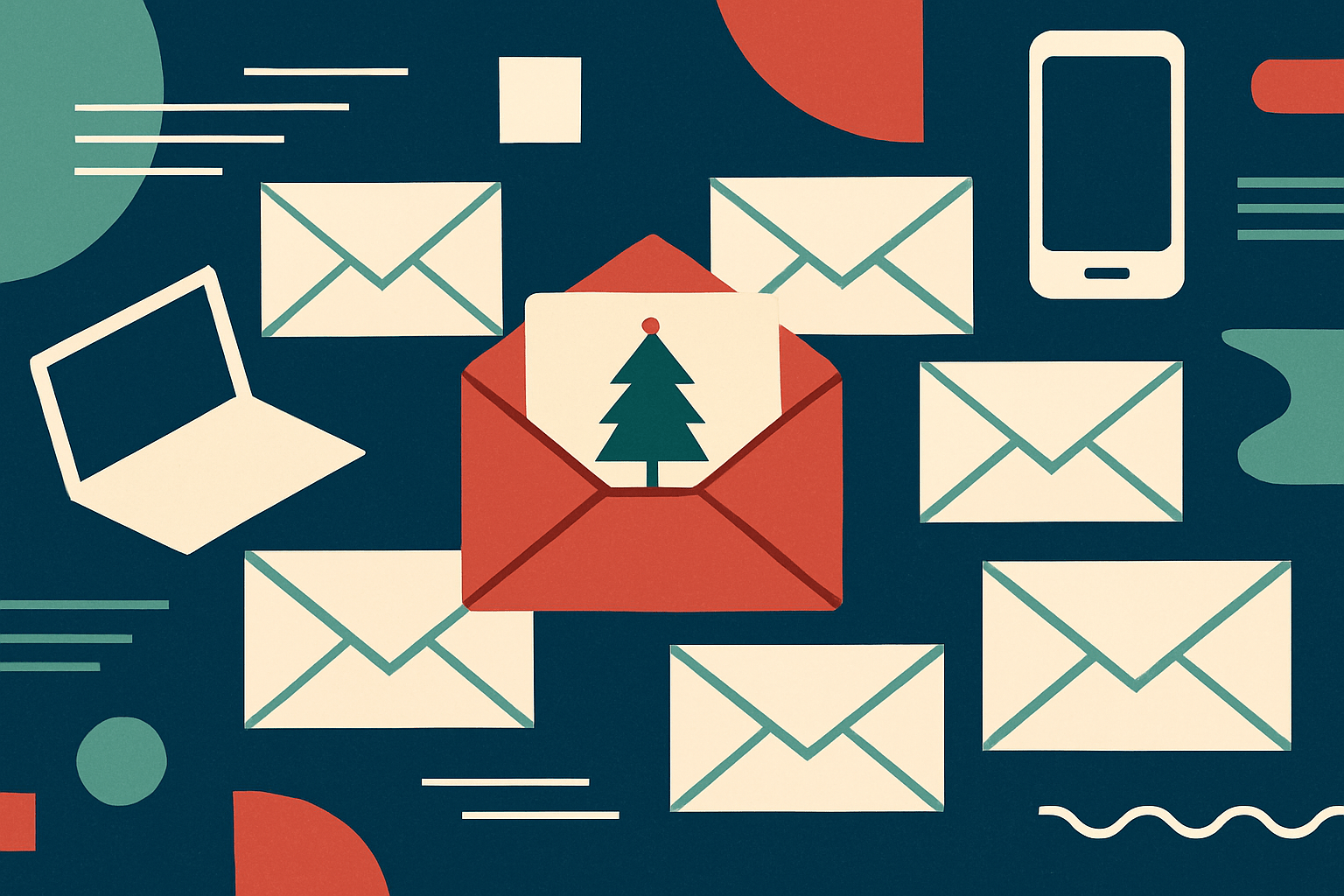
Prevent Email Overload: Strategies for Holiday Campaign Success
Stand Out This Holiday Season
Effective email marketing strategies to ensure your messages shine during the holiday rush.
Understanding the Holiday Email Surge
The holiday season is one of the most lucrative yet competitive times for email marketing. As brands ramp up their communication, inboxes become saturated, making it crucial for your emails to not only reach your recipients but also engage them. The challenge lies in navigating this surge while maintaining effective email segmentation and ensuring high email engagement.
During peak shopping times, the average consumer receives dozens, if not hundreds, of emails daily. Recent statistics show that holiday email volume increases significantly, leading to heightened competition for attention. Therefore, your email marketing strategy must adapt to these dynamics to ensure your messages are not lost in the influx.
Consumers are bombarded with promotional content, and understanding their behavior during the holiday season can give you an edge. This period is marked by increased impulse buying and emotional spending, driven by festive sentiments. By tailoring your messages to resonate with these motivations, you can enhance engagement and conversions.
Crafting Compelling Email Subject Lines
Email subject lines play a pivotal role in determining whether your emails are opened or ignored. Given the crowded nature of holiday inboxes, your subject lines must be eye-catching and concise. Aim to evoke curiosity or urgency without being overly promotional.
For example, instead of a generic subject line like ‘Holiday Sale is Here!’, consider something more engaging like ‘Unlock Your Exclusive Holiday Treats – Limited Time Only!’. This approach emphasizes urgency and exclusivity, prompting recipients to take action.
Another best practice is personalization, such as including the recipient’s name or preferences in the subject line. For instance, ‘Your Perfect Holiday Gift Awaits, [Name]!’ This level of personalization can significantly increase open rates and engagement.
Segmentation: Targeting for Relevance
Email segmentation is essential during the holiday season. By dividing your audience based on specific criteria, you can send tailored messages that resonate more with different groups. Segmentation criteria can include past purchase behavior, browsing history, geographic location, or engagement levels.
An effective example of segmentation is to target lapsed customers with a “We Miss You” email campaign, offering them special discounts or incentives to return. Conversely, loyal customers could receive sneak peeks of upcoming products or exclusive access to sales, reinforcing their loyalty and encouraging further purchases.
Additionally, consider segmenting your audience based on the holiday themes they respond to. For instance, families may appreciate promotions related to children’s products or experiences, while young adults might be more interested in tech gadgets or fashionable gifts. By targeting content to these interests, you enhance the effectiveness of your holiday campaigns.
Maximizing Email Engagement
Email engagement is critical to the success of any holiday campaign. Engagement metrics such as open rates, click-through rates, and conversion rates provide insight into how well your content resonates with your audience. To improve engagement, leverage tactics such as A/B testing to determine which subject lines and content perform best.
Providing clear and compelling calls to action is also vital. For instance, instead of using vague directions like “Click Here,” opt for more specific calls such as “Shop Our Holiday Collection Now!” This creates a clearer pathway for your audience to follow and increases the likelihood of action.
Incorporate visually appealing elements into your emails as well. Use eye-catching graphics that align with your branding and holiday theme, and ensure your email design is mobile-responsive, as many users will access their emails via smartphones or tablets.
Implementation: A Step-by-Step Workflow
Implementing these strategies requires a structured approach. Here’s a simple workflow you can execute this week:
- Review Past Campaigns: Analyze data from previous holiday campaigns to identify what worked and what didn’t. Look at open rates, click-through rates, and sales conversions.
- Create Audience Segments: Utilize your email marketing platform to segment your audience based on past purchases, engagement history, and demographics.
- Craft Subject Lines: Develop a range of compelling subject lines, using the insights from your analysis and include personalization where possible.
- Design and Schedule Emails: Create visually appealing email templates that align with your holiday branding. Schedule your emails strategically to allow for maximum engagement.
- Plan A/B Tests: Set up A/B tests for different subject lines and email designs to measure which variations perform best and adjust your strategy accordingly.
- Monitor Performance: Track your email engagement metrics closely after sending campaigns and tweak your strategies as necessary based on real-time data.
Framework for Success
Utilize the following framework to guide your holiday email marketing efforts:
- Focus on Content Quality: Ensure that all email content is relevant, engaging, and provides real value to your subscribers.
- Employ Data-Driven Decisions: Use analytics to continually refine your audience segments and improve targeting.
- Consistency is Key: Maintain a consistent brand voice and theme throughout your holiday campaigns, reinforcing your brand identity.
- Feedback Loop: Encourage audience feedback and engagement through surveys or interactive content. Use this to inform future campaigns.
- Measure KPIs: Focus on KPIs such as open rates, click rates, conversion rates, and ROI to gauge campaign effectiveness.
Addressing Common Misconceptions
A prevalent misconception is that more emails result in better engagement during the holiday season. Many marketers assume that bombarding their audience with multiple emails will lead to increased sales. However, this strategy can backfire.
Overloading recipients with emails can lead to higher unsubscribe rates and diminished brand loyalty. Instead of quantity, focus on quality and relevance. A well-timed, thoughtfully crafted email can outperform numerous generic messages. Less truly can be more when it comes to holiday email marketing.
Key Performance Indicators and Pitfalls to Avoid
Identifying accurate KPIs is essential in measuring the success of your holiday campaigns. Key metrics to monitor include open rates, click-through rates, conversion rates, unsubscribe rates, and overall ROI.
Common pitfalls to avoid include failing to personalize emails, not segmenting your audience, and neglecting mobile optimization. Each of these factors can detract from the effectiveness of your holiday campaigns, resulting in missed opportunities for engagement and conversion.
Ensure you are also testing different approaches throughout your campaigns to stay agile in your strategy. The holiday landscape can change rapidly, so being prepared to pivot can enhance your overall success.
Next Steps for Keeping Emails from Getting Lost in the Holiday Inbox Surge
There has never been a better time to refine your email marketing strategies for the holidays. Implement these tactics to ensure your brand not only stays visible but thrives amid the inbox surge. Start by analyzing your audience and creating a targeted approach using segmentation and compelling subject lines. Focus on creating quality content that speaks directly to your customers’ desires during the holiday season.
Whether you’re launching new holiday campaigns or looking to optimize existing ones, make sure to stay engaged with your audience and adjust your strategies based on real-time performance metrics. Remember, it’s all about staying relevant and resonating with your audience’s needs. Do not hesitate to reach out for expert advice tailored to your specific goals and challenges.
Let’s work together to elevate your email marketing this holiday season!


